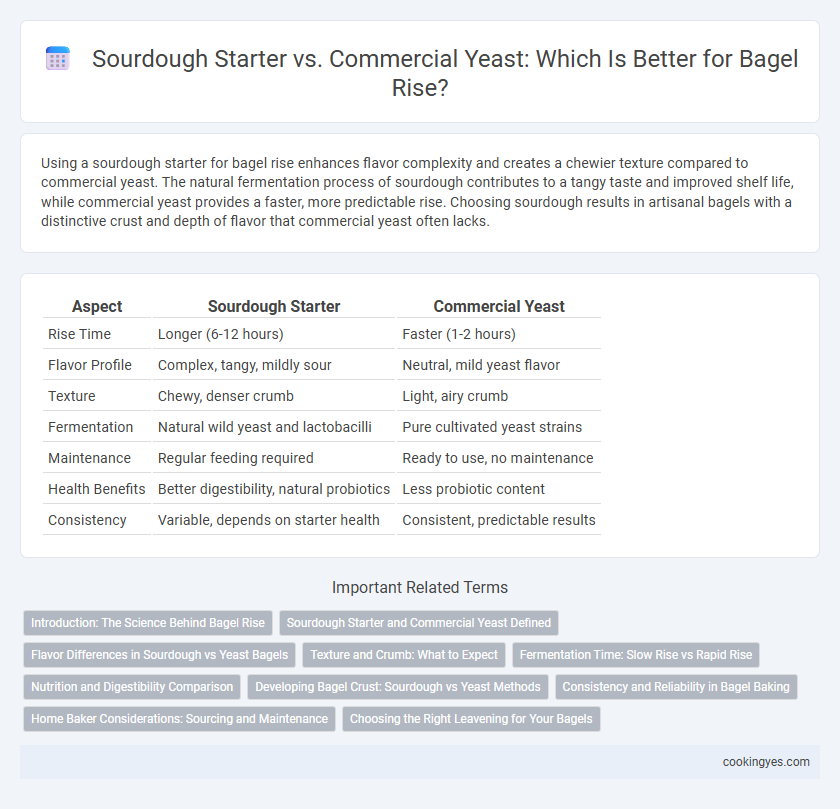Using a sourdough starter for bagel rise enhances flavor complexity and creates a chewier texture compared to commercial yeast. The natural fermentation process of sourdough contributes to a tangy taste and improved shelf life, while commercial yeast provides a faster, more predictable rise. Choosing sourdough results in artisanal bagels with a distinctive crust and depth of flavor that commercial yeast often lacks.
Table of Comparison
| Aspect | Sourdough Starter | Commercial Yeast |
|---|---|---|
| Rise Time | Longer (6-12 hours) | Faster (1-2 hours) |
| Flavor Profile | Complex, tangy, mildly sour | Neutral, mild yeast flavor |
| Texture | Chewy, denser crumb | Light, airy crumb |
| Fermentation | Natural wild yeast and lactobacilli | Pure cultivated yeast strains |
| Maintenance | Regular feeding required | Ready to use, no maintenance |
| Health Benefits | Better digestibility, natural probiotics | Less probiotic content |
| Consistency | Variable, depends on starter health | Consistent, predictable results |
Introduction: The Science Behind Bagel Rise
Sourdough starter relies on wild yeast and lactic acid bacteria to ferment dough, producing complex flavors and a chewier texture in bagels. Commercial yeast, typically Saccharomyces cerevisiae, acts faster, delivering a more consistent rise and lighter crumb structure. The choice between sourdough starter and commercial yeast significantly impacts fermentation time, flavor profile, and overall bagel quality.
Sourdough Starter and Commercial Yeast Defined
Sourdough starter is a natural leavening agent made from wild yeast and lactobacillus bacteria, which ferment flour and water over time, imparting a complex flavor and a chewier texture to bagels. Commercial yeast, typically Saccharomyces cerevisiae, is a cultivated and concentrated form of yeast that provides a faster and more predictable rise, resulting in a lighter and more uniform bagel crumb. Understanding the differences between sourdough starter and commercial yeast is essential for bakers aiming to control the bagel's taste, texture, and fermentation process.
Flavor Differences in Sourdough vs Yeast Bagels
Sourdough starter imparts a complex, tangy flavor to bagels due to its natural fermentation process, which develops organic acids and wild yeast strains. In contrast, commercial yeast produces a milder, more consistent rise resulting in a less pronounced, neutral taste. The extended fermentation time required for sourdough bagels enhances depth and subtle sour notes that are absent in typical yeast-leavened bagels.
Texture and Crumb: What to Expect
Sourdough starter creates a denser, chewier texture in bagels with a more complex, open crumb structure due to natural fermentation and longer proofing times. Commercial yeast yields a lighter, softer crumb with a tighter, more uniform texture, providing consistent rise and quicker preparation. The choice directly impacts the bagel's chewiness and flavor depth, with sourdough offering a tangier taste and artisanal feel.
Fermentation Time: Slow Rise vs Rapid Rise
Sourdough starter requires a slow rise due to its wild yeast and bacterial culture, which enhances the bagel's depth of flavor and chewy texture through prolonged fermentation. Commercial yeast offers a rapid rise, enabling quicker production but often resulting in a milder taste and softer crumb. Fermentation time directly impacts the bagel's crust development and overall complexity, with sourdough fermentation producing a more robust and artisanal bite.
Nutrition and Digestibility Comparison
Sourdough starter enhances bagel nutrition by promoting the growth of beneficial lactic acid bacteria and wild yeast, which improve mineral absorption and increase bioavailability of nutrients. In contrast, commercial yeast provides a faster rise but lacks these probiotic benefits, resulting in less fermentation-driven nutrient development. Sourdough fermentation also breaks down gluten and phytic acid, making bagels more digestible and reducing potential gastrointestinal discomfort compared to commercial yeast-leavened bagels.
Developing Bagel Crust: Sourdough vs Yeast Methods
Sourdough starter enhances bagel crust development by promoting complex fermentation that yields a chewier texture and tangy flavor through natural wild yeast and lactic acid bacteria. Commercial yeast produces a quicker rise with a consistent, but less nuanced crust, resulting in a smoother surface and milder taste. The slow fermentation of sourdough thickens the crust and intensifies caramelization during baking, creating a distinctive artisanal bagel experience.
Consistency and Reliability in Bagel Baking
Sourdough starter offers unique flavor complexity but can vary in activity, making consistency in bagel rise less predictable compared to commercial yeast. Commercial yeast delivers reliable fermentation rates and consistent dough expansion, ensuring uniform bagel texture and size across batches. Professional bakers often prefer commercial yeast for its dependable rise and controlled fermentation time in high-volume bagel production.
Home Baker Considerations: Sourcing and Maintenance
Home bakers choosing between sourdough starter and commercial yeast for bagel rising should consider sourcing and maintenance requirements. Sourdough starter demands regular feedings with flour and water to maintain active fermentation, offering complex flavors but requiring commitment. Commercial yeast is widely available, easy to store, and provides predictable rise times, making it convenient for consistent results in home baking.
Choosing the Right Leavening for Your Bagels
Sourdough starter imparts a complex, tangy flavor and a chewier texture to bagels, enhancing their artisanal quality with natural fermentation and longer rise times. Commercial yeast offers a consistent, faster rise and a milder flavor, ideal for bakers seeking efficiency and predictability in their bagel production. Selecting between sourdough starter and commercial yeast depends on the desired taste profile, texture, and baking timeline for perfect bagel leavening.
Sourdough starter vs commercial yeast for bagel rise Infographic

 cookingyes.com
cookingyes.com